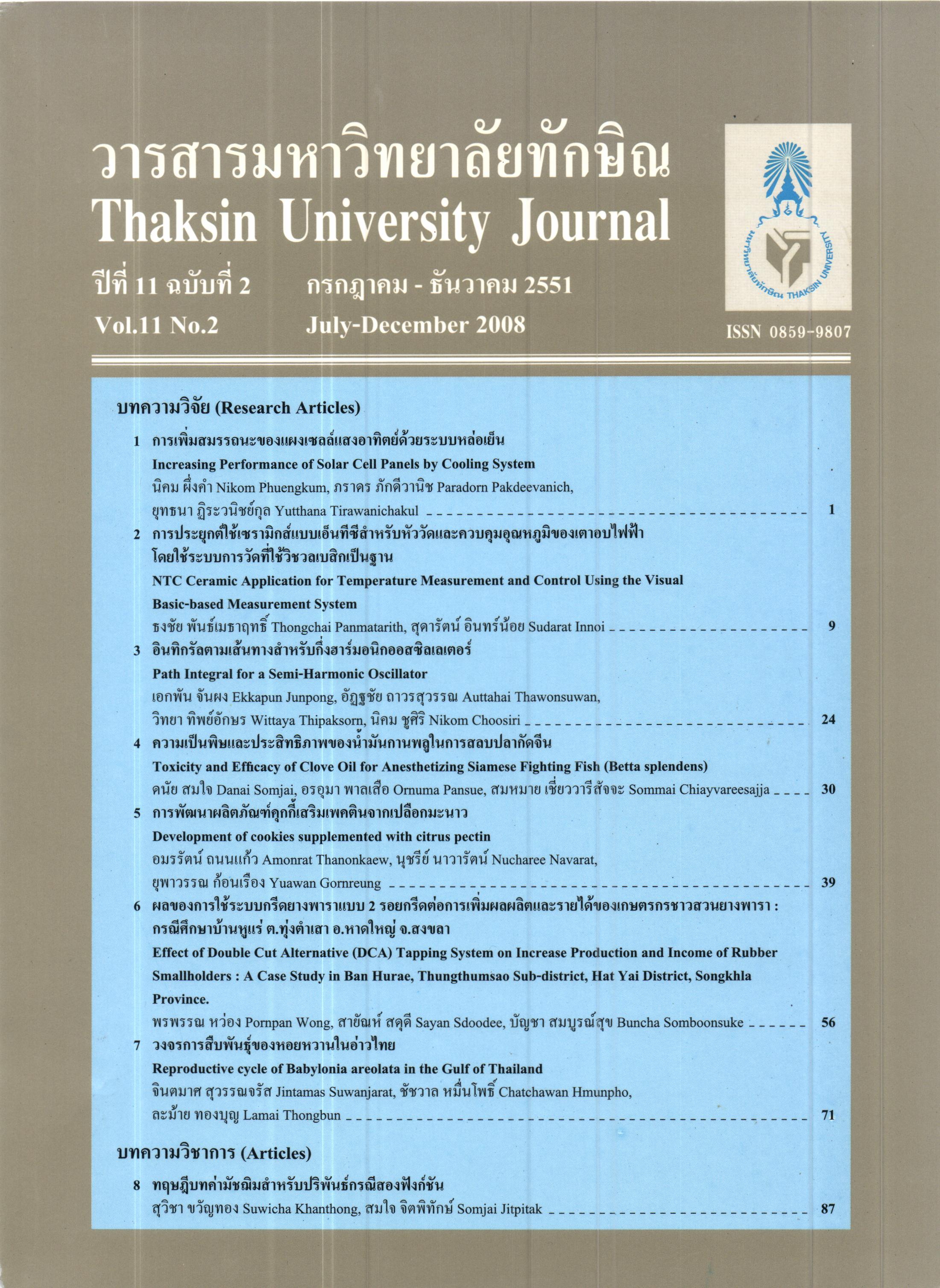ผลของการใช้ระบบกรีดยางพาราแบบ 2 รอยกรีดต่อการเพิ่มผลผลิตและรายได้ของเกษตรกรชาวสวนยาง : กรณีศึกษาบ้านหูแร่ ต.ทุ่งตำเสา อ.หาดใหญ่ จ.สงขลา
Main Article Content
Abstract
In Songkhla Province, the rubber farmer normally prefers high-frequency tapping system, this leads to detrimental impact on rubber trees. Therefore, double cut alternative tapping system (DCA) (2x1/3S d/4) was introduced to compare with a conventional tapping system (1/3S 2d/3). An experiment was established at Ban Hurae, Thungthumsao Sub-district, Hat Yai District, Songkhla Province during April 2007-March 2008. The results showed that DCA tapping system had higher average production (22%) than that of conventional tapping system, and low cut had higher production than that of high cut. The dry rubber content (DRC) and growth rate were not significant difference. Net income from DCA tapping system was 14,955.06 baht/rai/year and conventional tapping system was 10,955.06 baht/ rai/year, this indicated that DCA tapping system provided higher total net income 3,208.48 baht/rai/year than that of the conventional tapping system. From the results, it is suggested that farmers’ decision making of using DCA tapping system depends on production, renew bark period, tapping panel disease, percentage of DRC and income. However, this is a preliminary study, it has to be investigated further to assess long-term impact.
จากการสำรวจเกษตรกรชาวสวนยางพาราในจังหวัดสงขลา พบว่าเกษตรกรนิยมใช้ระบบกรีดยางแบบถี่ ซึ่งจะส่งผลเสียระยะยาวต่อต้นยางพารา จึงได้ทดลองใช้ระบบกรีดแบบ 2 รอยกรีด (Double Cut Alternative Tapping System: DCA) โดยแบ่งความยาวรอยกรีดเป็น 1 ใน 3 ของลำต้น 2 รอย รอบกรีดบนและล่าง สลับหน้ากรีดโดยกรีด 2 วันหยุด 1 วัน (2x1/3S d/4) เปรียบเทียบกับระบบกรีดแบบ 1 รอยกรีดซึ่งเป็นระบบกรีดที่เกษตรกรใช้อยู่ทั่วไป(1/ 3S 2d/3) ทำการทดลองที่บ้านหูแร่ ตำบลทุ่งตำเสา อำเภอหาดใหญ่ จังหวัดสงขลา ช่วงเดือนเมษายน 2550 ถึงเดือน มีนาคม 2551 ผลปรากฏว่าปริมาณผลผลิตเฉลี่ยของระบบกรีด DCA สูงกว่าระบบกรีดแบบ 1 รอยกรีด ประมาณ 22 เปอร์เซ็นต์ และรอยกรีดล่างมีปริมาณผลผลิตสูงกว่ารอยกรีดบน สำหรับเปอร์เซ็นต์เนื้อยางแห้งและอัตราการเจริญ เติบโตทางลำต้นของยางพาราระหว่างวิธีการทดลองไม่มีความแตกต่างทางสถิติ เมื่อพิจารณาต้นทุนผลตอบแทน เบื้องต้น พบว่า เกษตรกรได้กำไรสุทธิจากระบบกรีด DCA 14,955.06 บาท/ไร่/ปี ขณะที่ระบบกรีดแบบแบบ 1 รอย เกษตรกรได้กำไรสุทธิ 10,955.06 บาท/ไร่/ปี แตกต่างกัน 3,208.48 บาท/ไร่/ปี สำหรับเงื่อนไขที่เกษตรกรที่ศึกษาเลือก ใช้ระบบกรีด DCA ขึ้นอยู่กับ ปริมาณผลผลิต ระยะเวลาการงอกของเปลือก ต้นยางไม่เสียหาย เปอร์เซ็นต์เนื้อยางแห้ง และรายได้ อย่างไรก็ตามการศึกษาครั้งนี้เป็นการศึกษาเบื้องต้น จำเป็นที่จะต้องศึกษาถึงผลกระทบในระยะยาวต่อไป


